Optimization and Application of Water Injection Process in Gas-Bearing Coal Seam
Abstract
:1. Introduction
Water Injection Technology
2. The “ Stress–Seepage ” Coupling Characteristics of Coal around Boreholes
2.1. Stress Distribution Characteristics of Coal around Boreholes
2.1.1. Stress Distribution Characteristics of Coal around the Borehole Prior to Water Injection
2.1.2. Stress Distribution Characteristics of the Coal around the Borehole after Water Injection
2.2. Seepage Characteristics of Coal around Boreholes
3. Optimization of the Water Injection Process in a Gas-Bearing Coal Seam
3.1. Sealing Process Optimization
3.2. Coal Seam Water Injection Process Optimization
3.2.1. Adding a Surfactant
3.2.2. Water Injection Pressure Optimization
3.2.3. Optimization of the Water Injection Equipment
4. Field Test and Implementation Effect
4.1. Field Test Schematic Design
Water Injection Test Steps
- (1)
- Before the start of water injection, thickener is added to the matching water tank to improve the viscosity of the fluid. According to the ratio, clean water is injected into the matching water tank and stirred evenly to complete the preparation of the thickener. Then, the water injection pump is started, and the flow regulation valve is used to continuously increase the water injection flow rate, so as to open multiple water injection main cracks and promote the expansion of secondary cracks.
- (2)
- When the water injection flow is increasing and the water injection pressure begins to decrease, it indicates that the water injection initiation process is completed. The fluid is replaced with a prepared surfactant, and the water injection flow is continuously increased through the water injection pump to reduce the fluid viscosity, increase the fluidity, and expand the influence range of the water injection.
- (3)
- When the water injection flow rate increases continuously and the water injection pressure increases again, it indicates that the water is wetted by seepage under the dual action of capillary force and surface tension. The fluid is replaced with a prepared high-concentration surfactant, and the water injection flow is continuously increased through the water injection pump to continuously reduce the surface tension between the liquid–solid two-phase contact surface and promote the further migration of water.
4.2. Water Injection Efficiency Analysis
4.2.1. Investigation of the Sealing Effect Prior to Water Injection
4.2.2. Investigation of the Water Injection Effect on the On-Site Coal Seam
5. Conclusions and Prospects
5.1. Conclusions
5.2. Prospects
- (1)
- As the coal seam is a typical grey system, it is impossible to directly obtain the actual change in stress in the process of water injection. With laboratory experiments and field tests, it is also difficult to completely reproduce the evolution characteristics of stress in the process of water injection that occur under the real mechanical environment. In this paper, the change in the coal stress field around the water injection borehole was obtained by numerical simulation. In the future, the real-time monitoring function of coal stress and strain in the seepage process can be realized by further improving the experimental system and using experimental research methods.
- (2)
- In the process of carrying out the engineering practice of step-by-step control technology for coal seam water injection, although the parameters, such as water injection pressure-flow rate, in this paper realized the real-time monitoring of the whole process of water injection, the control of key parameters and the core control equipment still need further study, and on this basis, the automatic and accurate solution of a mathematical analytical model was realized, and the automatic and intelligent coal seam water injection was completed, so as to further improve the effect of coal seam water injection disaster reduction.
Author Contributions
Funding
Institutional Review Board Statement
Informed Consent Statement
Data Availability Statement
Acknowledgments
Conflicts of Interest
References
- Liu, Z.; Hu, P.; Yang, H.; Yang, W.; Gu, Q. Coupling mechanism of coal body stress-seepage around a water injection borehole. Sustainability 2022, 14, 9599. [Google Scholar] [CrossRef]
- Liu, Z.; Jiao, L.; Yang, H.; Zhu, M.; Zhang, M.; Dong, B. Study on the microstructural characteristics of coal and the mechanism of wettability of surfactant solutions at different pH levels. Fuel 2023, 353, 129268. [Google Scholar] [CrossRef]
- Zeng, M.; Shi, S.; Lu, Y.; Li, H.; Wu, K. Research on current situation of coal and gas symbiosis disaster. China Energy Environ. Prot. 2020, 42, 6–9. [Google Scholar]
- Xu, T.; Wang, X. Statistics and Law Analysis of Gas Explosion Accidents in Low Gas Coal Mines in China in Recent Ten Years. Min. Saf. Environ. Prot. 2021, 48, 126–130. [Google Scholar]
- Deng, Q.; Wang, Y.; Liu, M. Statistical analysis and enlightenment of coal mine accidents in China from 2001 to 2013 years. Coal Technol. 2014, 33, 73–75. [Google Scholar]
- Li, B. Study on the basic characteristics and occurrence law of coal and gas outburst accident in China from 2001 to 2012. J. Saf. Environ. 2013, 13, 274–278. [Google Scholar]
- Weissman, D.N. Progressive massive fibrosis: An overview of the recent literature. Pharmacol. Ther. 2022, 240, 108232. [Google Scholar] [CrossRef]
- Ferguson, J.M.; Costello, S.; Elser, H.; Neophytou, A.M.; Picciotto, S.; Silverman, D.T.; Eisen, E.A. Chronic obstructive pulmonary disease mortality: The diesel exhaust in miners study (DEMS). Environ. Res. 2019, 180, 108876. [Google Scholar] [CrossRef]
- Düzgün, H.S.; Leveson, N. Analysis of soma mine disaster using causal analysis based on systems theory (CAST). Saf. Sci. 2018, 110, 37–57. [Google Scholar] [CrossRef]
- Trubetskoy, K.N.; Viktorov, S.D.; Iofis, M.A.; Grishin, A.V.; Shlyapin, A.V. Causes of man-Made accidents in gas-dynamically and geo-dynamically. Hazard. Coal Min. Min. Rep. 2017, 153, 101–105. [Google Scholar]
- Szlązak, N.; Obracaj, D.; Swolkien, J. Enhancing safety in the Polish high-methane coal mines: An overview. Min. Met. Explor. 2020, 37, 567–579. [Google Scholar] [CrossRef]
- Vorotnikov, V. Siberian Coal Mine Disaster Kills 52; Exposes Safety Shortfalls in Russian Mining Industry. Eng. Min. J. 2021, 222, 22. [Google Scholar]
- Durdán, M.; Laciak, M.; Kačur, J.; Flegner, P.; Kostúr, K. Evaluation of synthetic gas harmful effects created at the underground coal gasification process realized in laboratory conditions. Measurement 2019, 147, 106866. [Google Scholar] [CrossRef]
- Wang, J.; Song, T.; Kong, G.; Qi, W. Study on influential factors of dust wetting radius of water injection in coal seams. China Coal 2016, 42, 5. [Google Scholar]
- Cheng, W.; Liu, X.; Guo, Y.; Zhou, G.; Wang, G. Dust-proof technology with combined seam water injection for fully mechanized top coal caving mining face. Coal Sci. Technol. 2008, 36, 5. [Google Scholar]
- Zhang, H. Practice of spontaneous combustion prevention by water injection in closed goaf of flammable coal seam. Jiangxi Coal Sci. Technol. 2015, 146, 10–12. [Google Scholar]
- Cheng, G.; Hou, J.; Si, J.; Li, L. Research on influence law of key parameters of coal seam water injection for dust reduction. Saf. Coal Mines 2021, 52, 188–193. [Google Scholar]
- Zhang, D. Research on Water Injection Technology of II-1 Coal Seam in Xindeng Coal Industry. Ph.D. Thesis, North China Institute of Science and Technology, Yanjiao, China, 2020. [Google Scholar]
- Xiao, Y.; Sun, L. Study on Optimization and Effect of Coal Seam Water Injection Parameters in Mabao Coal Mine. Shanxi Coking Coal Technol. 2020, 44, 8–13. [Google Scholar]
- Cybulski, K.; Malich, B.; Wieczorek, A. Evaluation of the effectiveness of coal and mine dust wetting. J. Sustain. Min. 2015, 14, 83–92. [Google Scholar] [CrossRef]
- Gao, H. Research on Deep Hole Coal Seam Water Injection Technology in Coal Mining Face. Ph.D. Thesis, Anhui University of Science and Technology, Huainan, China, 2007. [Google Scholar]
- Zhao, C. Coal seam water injection process and effect analysis. Coal Sci. Technol. Mag. 2005, 45–47. [Google Scholar] [CrossRef]
- Zhang, X.; Cai, F.; Fei, Y.; Xuan, M.; Huang, Y. Application of coal seam water injection dust removal technology in fully mechanized excavation face. J. Saf. Sci. Technol. 2013, 9, 4. [Google Scholar]
- Liu, Y.; Si, C.; Zhang, Z. Application of Dynamic Pressure Water Injection in Dust Prevention of Fully Mechanized Excavation Face in Coal Roadway. Saf. Coal Mines 2008, 39, 2. [Google Scholar]
- Xiao, Z.; Wang, Z. Status and Progress of Studies on Mechanism of Preventing Coal and Gas Outburst by Coal Seam Infusion. China Saf. Sci. J. (CSSJ) 2009, 19, 150–158. [Google Scholar] [CrossRef]
- Zhao, D.; Feng, Z.; Zhao, Y. Experimental study on the influence of high pressure water injection on gas desorption characteristics of coal body. Chin. J. Rock Mech. Eng. 2011, 30, 9. [Google Scholar]
- Liu, Z.; Li, Z.; Yang, Y.; Ji, H. Experimental study on the influence of water on coal gas adsorption and radial seepage. Chin. J. Rock Mech. Eng. 2014, 33, 586–593. [Google Scholar]
- Wei, H. Study on Prevention and Control of Deep Impact-Ignition Compound Disaster by Coal Seam Water Injection with Chelating Wetting Agent. Ph.D. Thesis, Liaoning University, Shenyang, China, 2022. [Google Scholar]
- Xu, S. Risk assessment on unsafe behavior of coal miner based on Monte Carlo method. China Saf. Sci. J. 2020, 30, 172–178. [Google Scholar]
- Wang, L.; Sun, Y.; Chu, P.; Zhao, W.; Zou, S. Study on accuracy of coal seam gas pressure measurement based on its spatial and temporal distribution characteristics. China Saf. Sci. J. 2021, 31, 40–47. [Google Scholar]
- Lin, C. Experimental study on seepage and gas desorption of pulsating water injection in coal seam. Coal Eng. 2019, 51, 108–112. [Google Scholar]
- Wang, Q.; Zhou, X.; Liu, H.; Wang, W.; Si, L. Study on sealing length of high pressure water injection in Gaojiapu Coal Mine. Coal Mine Saf. 2019, 50, 149–152. [Google Scholar]
- Wang, X.; Yuan, P.; Ren, Z.; Xu, Q. Application and effect analysis of coal seam water injection technology. Coal Technol. 2020, 39, 97–99. [Google Scholar]
- Razavian, S.M.; Rezai, B.; Irannajad, M.; Ravanji, M.H. Numerical simulation of high voltage electric pulse comminution of phosphate ore. Int. J. Min. Sci. Technol. 2015, 25, 473–478. [Google Scholar] [CrossRef]
- Moisés, O.; Bustamante, R.; Alan, J.D.A.; Pablo, B.B. A study of fire propagation in coal seam with numerical simulation of heat transfer and chemical reaction rate in mining field. Int. J. Min. Sci. Technol. 2019, 29, 873–879. [Google Scholar]
- Giri, A.; Tarafdar, S.; Gouze, P.; Dutta, T. Multifractal analysis of the pore space of real and simulated sedimentary rocks. Geophys. J. Int. 2015, 200, 1108–1117. [Google Scholar] [CrossRef]
- Yang, H.; Cheng, W.; Liu, Z.; Wang, W.; Zhao, D.; Wang, W. Fractal characteristics of effective seepage channel structure of water infusion coal based on NMR experiment. Rock Soil Mech. 2020, 41, 8. [Google Scholar]
- Yan, J.; Wang, F.; Li, Y.; Gao, Y.; Li, Z.; Liu, H. A Feasibility Study of Coal Seam Water Injection Processes: The Effects of Coal Porosity and Mass Flow Rates of Injected Water on Wetting Radii. Energy Fuels 2020, 34, 16956–16967. [Google Scholar] [CrossRef]
- Lyu, X.; You, X.; He, M.; Zhang, W.; Wei, H.; Li, L.; He, Q. Adsorption and molecular dynamics simulations of nonionic surfactant on the low rank coal surface. Fuel 2018, 211, 529–534. [Google Scholar] [CrossRef]
- Zou, L.; Peng, X. The application principle, advantages and disadvantages and improvement measures of FLAC-3D are discussed. Sichuan Archit. 2007, 27, 3. [Google Scholar]
- Zhang, S.; Feng, J.; Han, R. FLAC3D numerical simulation study on the failure developing law of interface for geotechnical prestressed anchorage bolt. Adv. Mater. Res. 2013, 671–674, 50–53. [Google Scholar] [CrossRef]
- Gong, Y.; Guo, G. A data-intensive FLAC3D computation model: Application of geospatial big data to predict mining induced subsidence. Comput. Model. Eng. Sci. 2019, 119, 395–408. [Google Scholar] [CrossRef]
- Wang, W.; Liu, Z.; Song, K. Optimization and Application of Coal Seam Water Injection Process in Coal Mining Face. China Energy Environ. Prot. 2020, 42, 20–24. [Google Scholar]
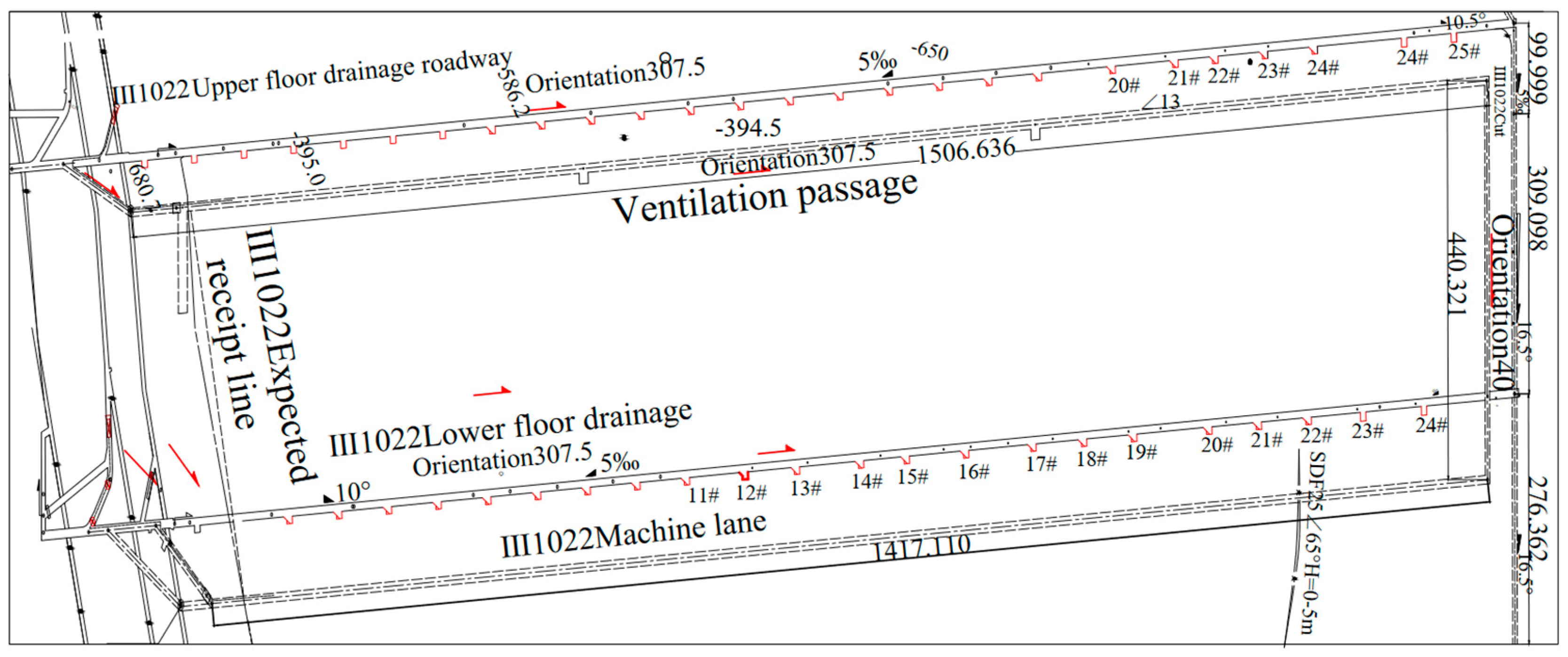
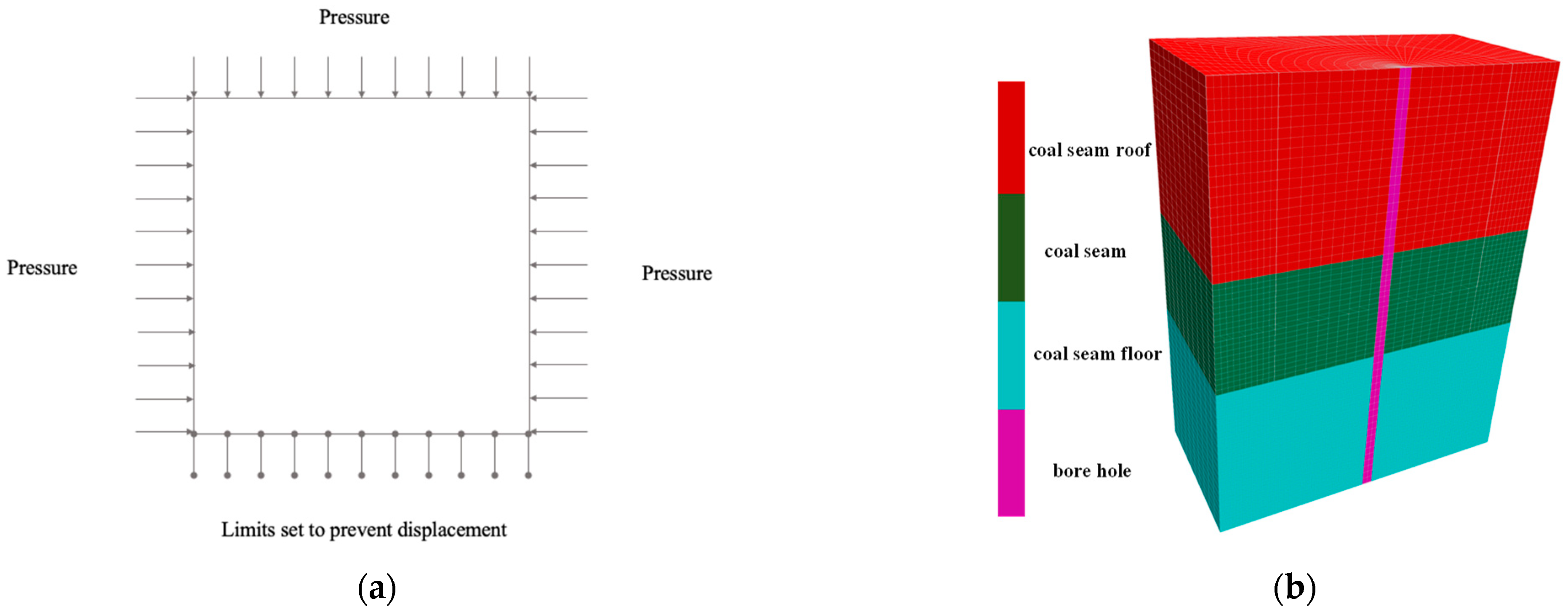


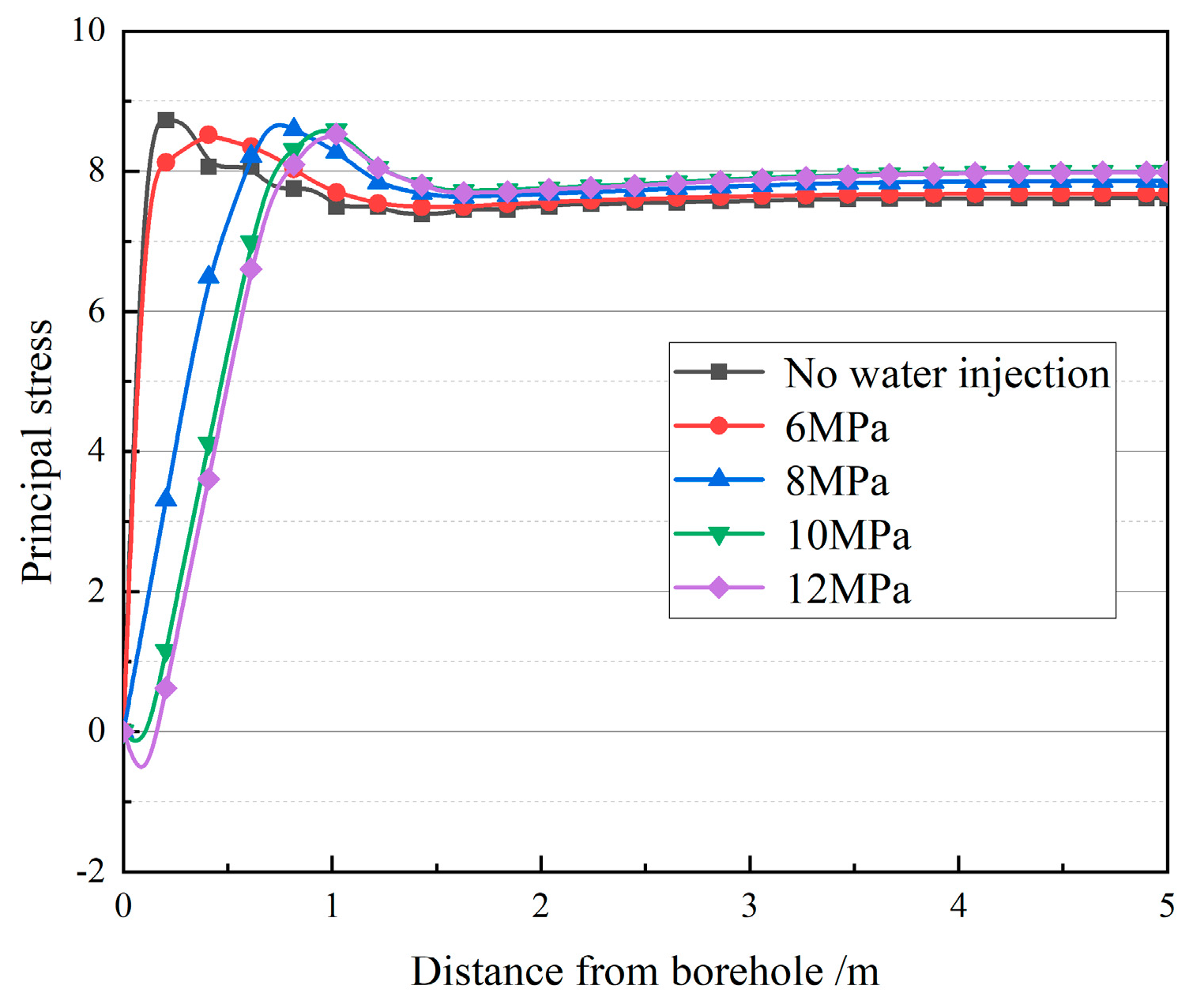
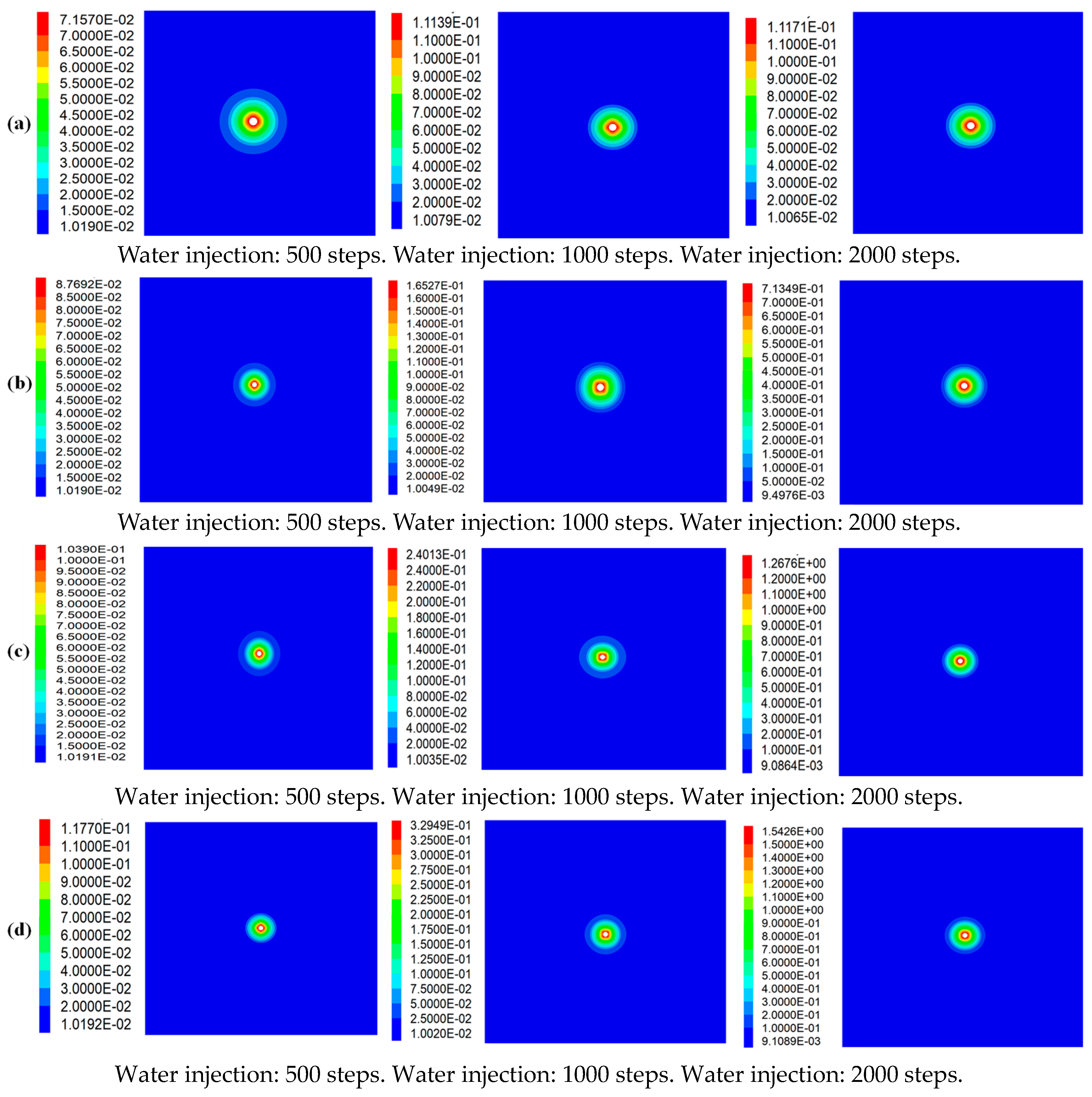
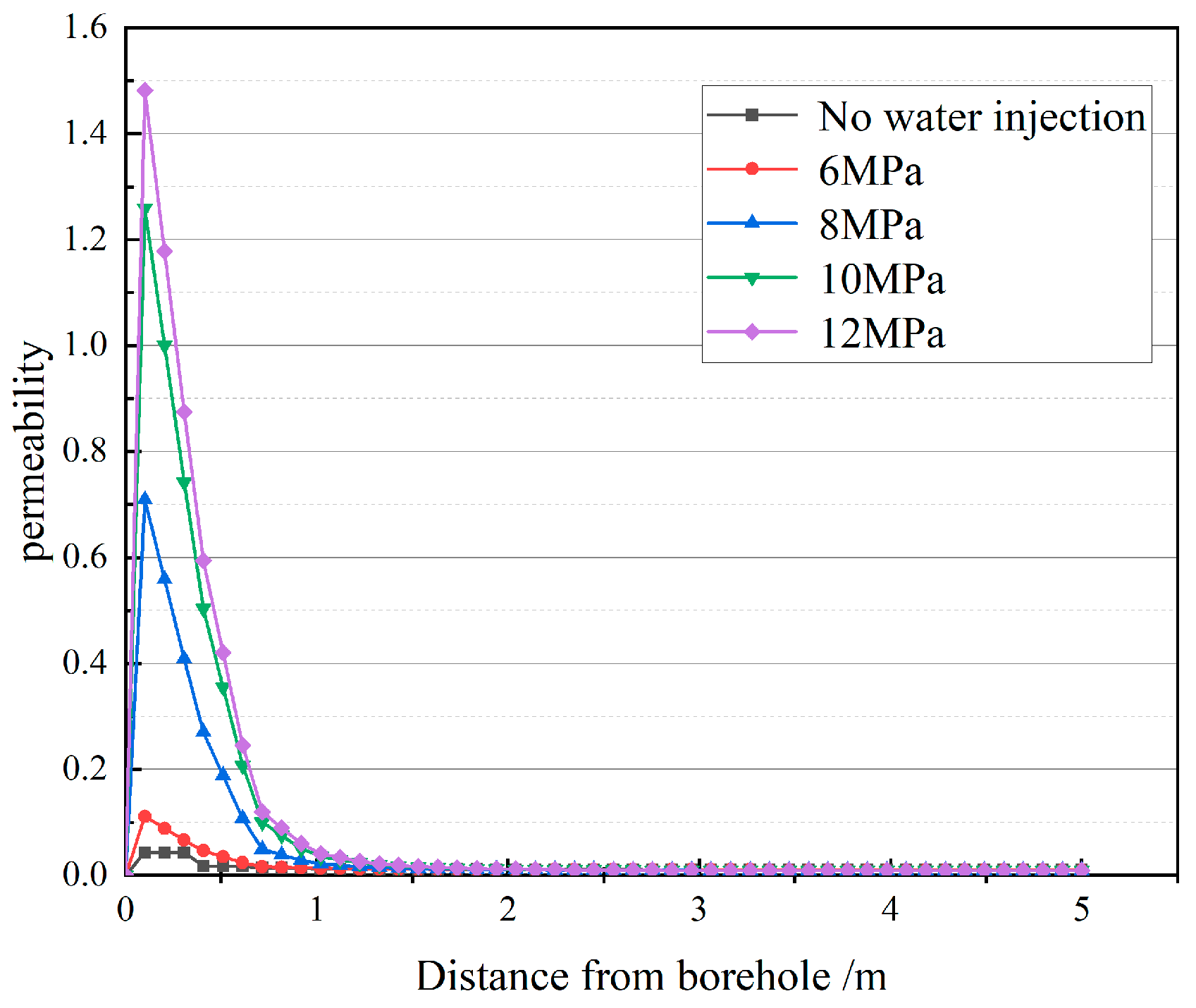
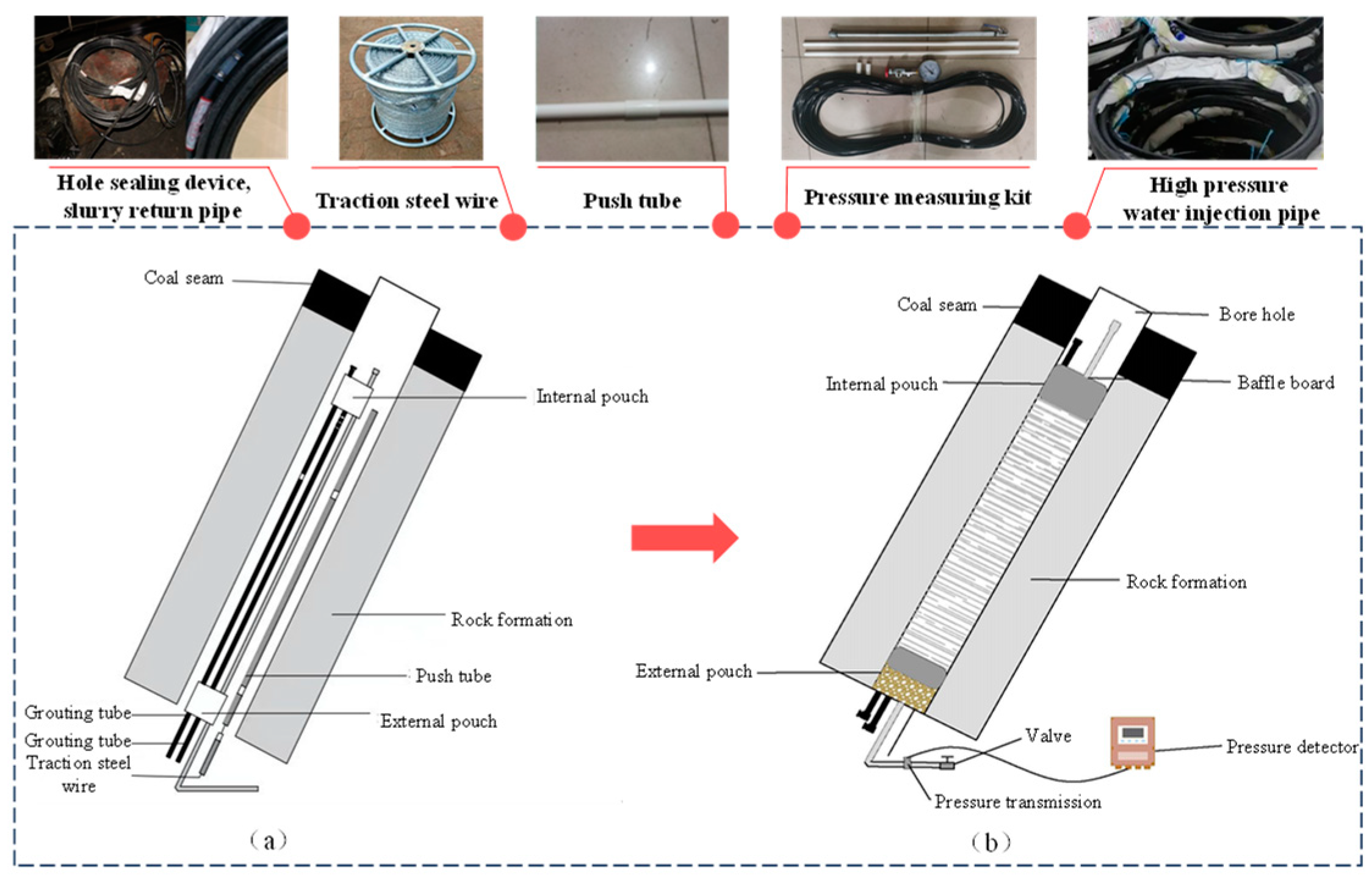


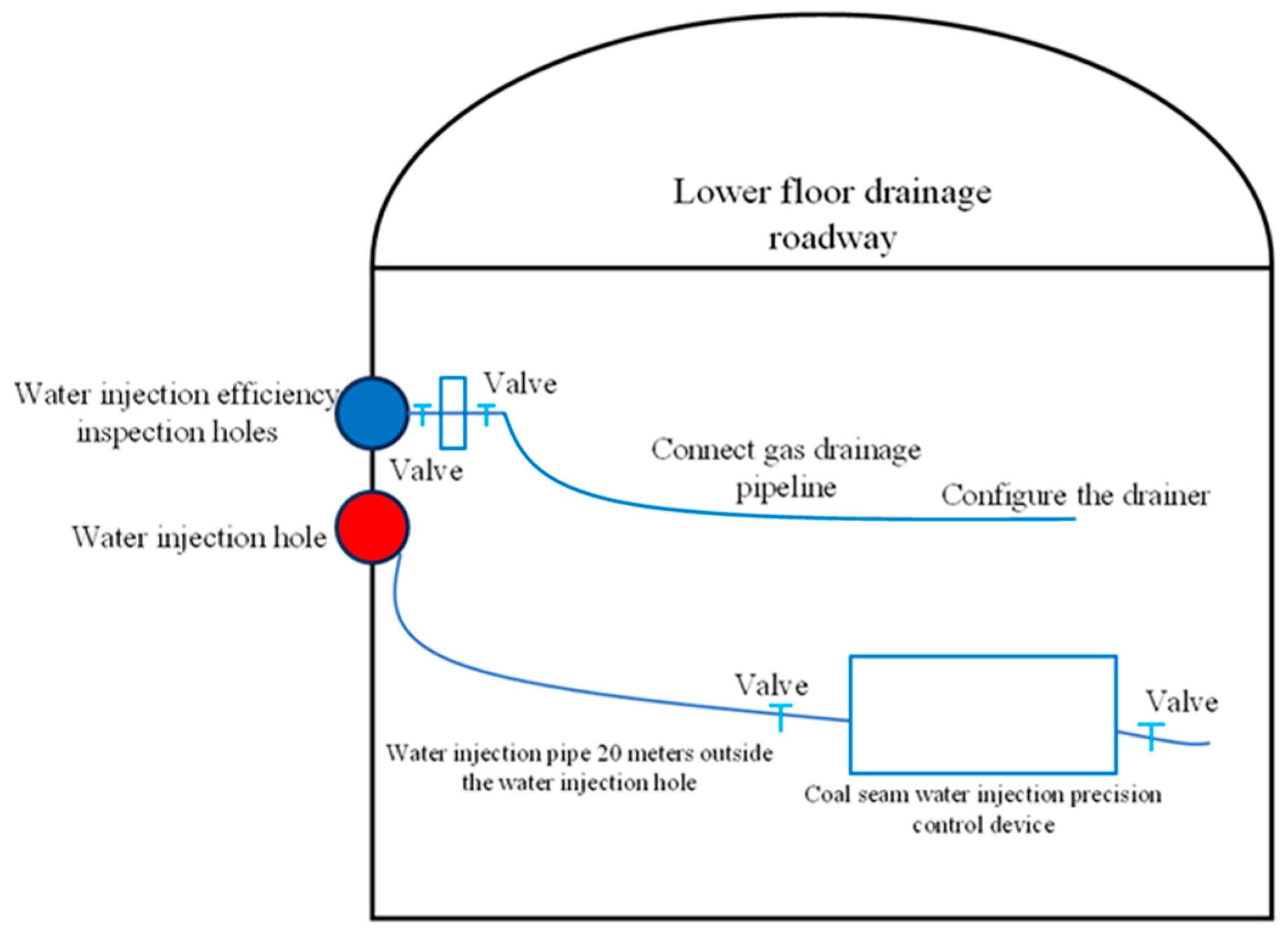

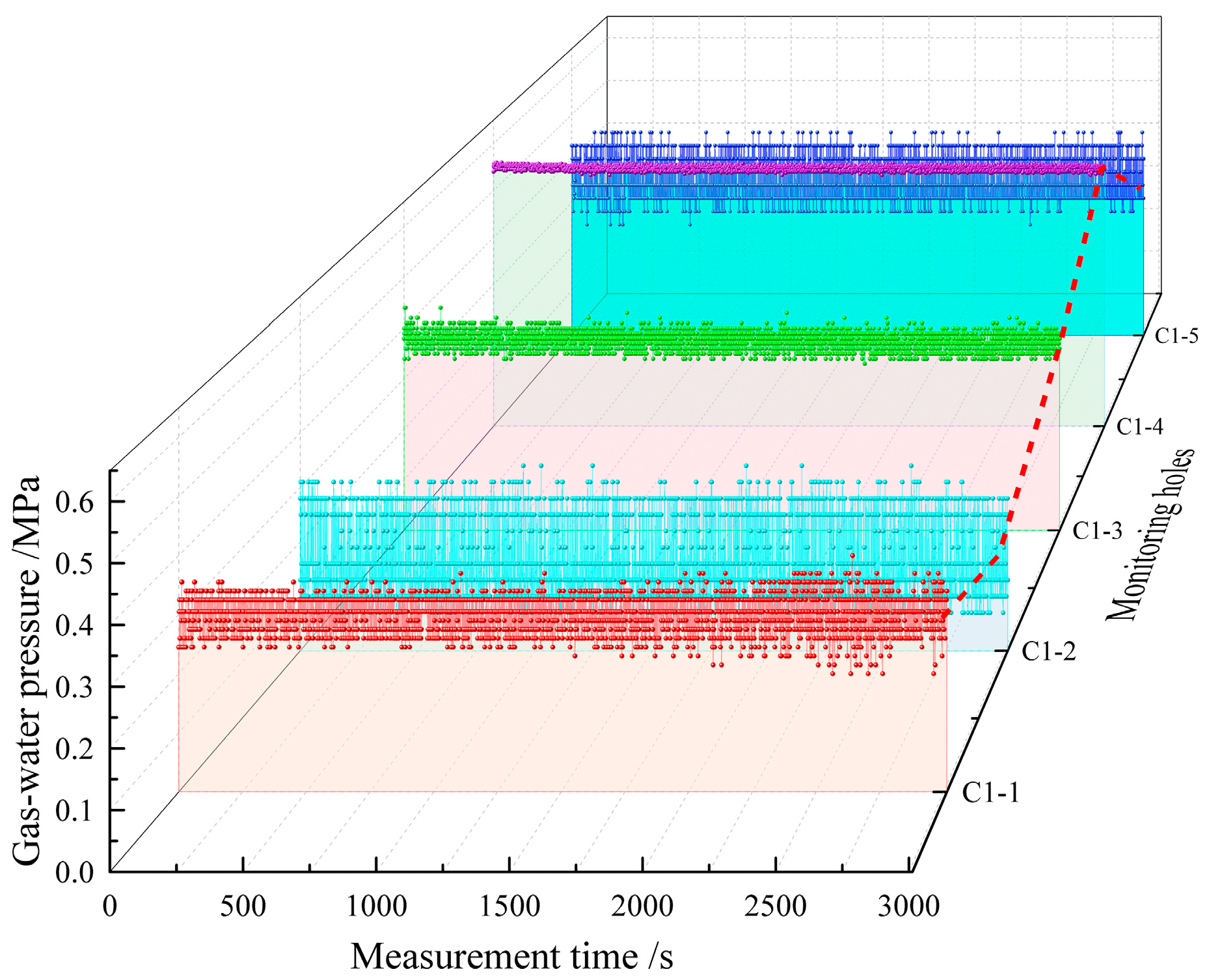
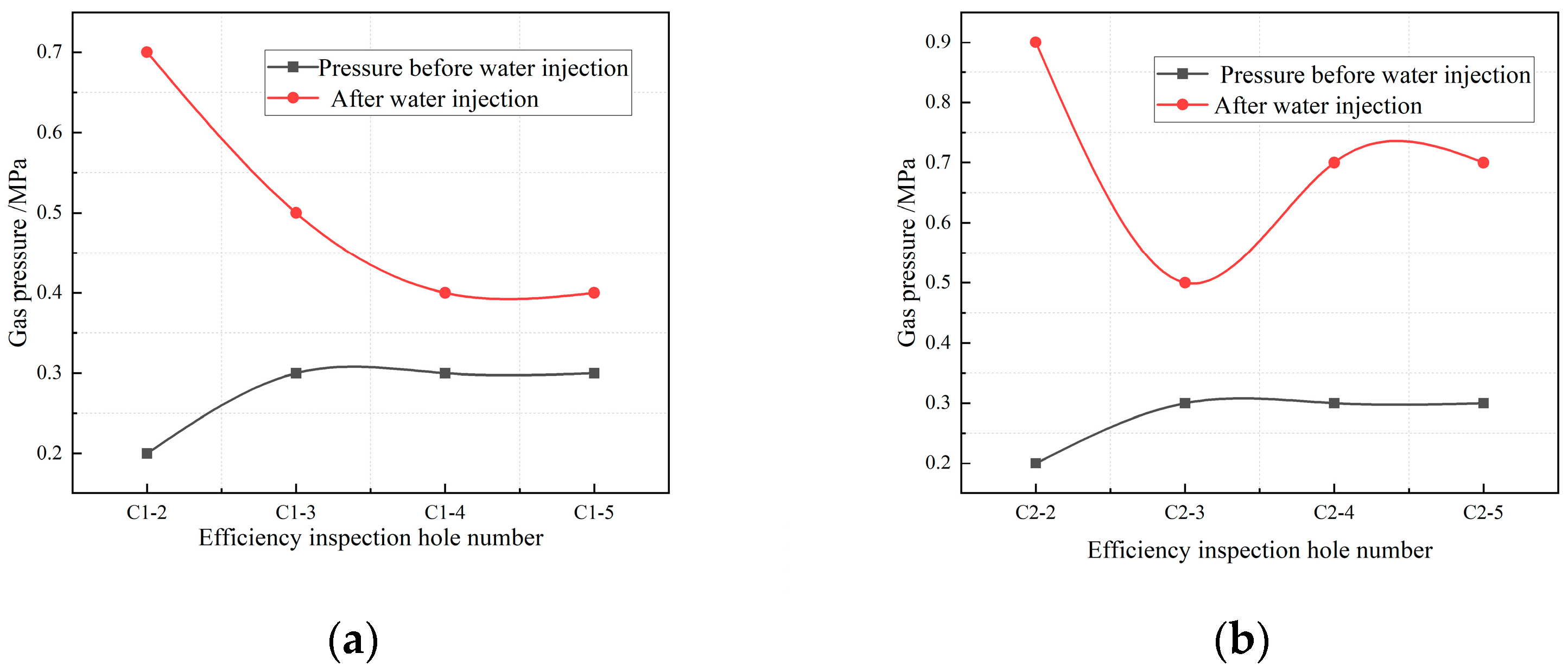
| Coal-and- Rock Strata | Density | Bulk Modulus [GPa] | Shear Modulus [GPa] | Tensile Strength [MPa] | Cohesion [MPa] | Internal Friction Angle [°] |
|---|---|---|---|---|---|---|
| Coal seam roof | 1300 | 15.6 | 10.8 | 1.74 | 9.95 | 25 |
| Coal seam | 1300 | 0.65 | 0.3 | 0.7 | 0.5 | 18 |
| Coal seam floor | 1450 | 22.6 | 11.1 | 1.58 | 6.72 | 42 |
| Test Number | Water Injection Pressure [MPa] | Duration of Water Injection | Duration of Water Injection | Duration of Water Injection |
|---|---|---|---|---|
| 1 | 6 | 500 | 1000 | 2000 |
| 2 | 8 | 500 | 1000 | 2000 |
| 3 | 10 | 500 | 1000 | 2000 |
| 4 | 12 | 500 | 1000 | 2000 |
| Hole Number | C1-1 | C1-2 | C1-3 | C1-4 | C1-5 | C2-1 | C2-2 | C2-3 | C2-4 | C2-5 |
|---|---|---|---|---|---|---|---|---|---|---|
| Dip angle of hole [°] | 77.0 | 74.9 | 80.0 | 77.0 | 77.0 | 77.0 | 74.9 | 80.0 | 77.0 | 77.0 |
| Depth of drilling coal [m] | 71.4 | 74.3 | 68.1 | 71.4 | 71.4 | 71.4 | 74.3 | 68.1 | 71.4 | 71.4 |
| Drilling depth through coal [m] | 4.9 | 5.2 | 4.6 | 4.9 | 4.9 | 4.9 | 5.2 | 4.6 | 4.9 | 4.9 |
| Group Number | Water Injection Pressure [MPa] | Flow Rate [m3/h] | Water Injection Volume [m3] | Average Influence Radius [m] | Water Content of the Coal around the Borehole before Water Injection [%] | Water Content of the Coal around the Borehole after Water Injection [%] |
|---|---|---|---|---|---|---|
| C1-1 | 0–10 | 2.00 | 2.67 | 3.00 | 1.31 | 3.73 |
| C2-1 | 0–10 | 2.00–4.00 | 5.60 | 3.60 | 1.35 | 4.42 |
Disclaimer/Publisher’s Note: The statements, opinions and data contained in all publications are solely those of the individual author(s) and contributor(s) and not of MDPI and/or the editor(s). MDPI and/or the editor(s) disclaim responsibility for any injury to people or property resulting from any ideas, methods, instructions or products referred to in the content. |
© 2023 by the authors. Licensee MDPI, Basel, Switzerland. This article is an open access article distributed under the terms and conditions of the Creative Commons Attribution (CC BY) license (https://creativecommons.org/licenses/by/4.0/).
Share and Cite
Lin, X.; Liu, Z.; Geng, N.; Hu, P.; Gu, Q. Optimization and Application of Water Injection Process in Gas-Bearing Coal Seam. Processes 2023, 11, 3003. https://doi.org/10.3390/pr11103003
Lin X, Liu Z, Geng N, Hu P, Gu Q. Optimization and Application of Water Injection Process in Gas-Bearing Coal Seam. Processes. 2023; 11(10):3003. https://doi.org/10.3390/pr11103003
Chicago/Turabian StyleLin, Xiaolu, Zhen Liu, Ning Geng, Peng Hu, and Qingbo Gu. 2023. "Optimization and Application of Water Injection Process in Gas-Bearing Coal Seam" Processes 11, no. 10: 3003. https://doi.org/10.3390/pr11103003




